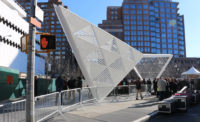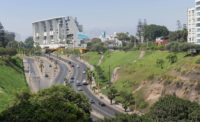In one of his final press appearances as mayor of New York City, Michael Bloomberg sealed the deal Thursday on one of his most ambitious urban endeavors: Cornell NYC Tech, a $2-billion science and technology campus designed by a cast of architectural heavyweights including Morphosis Architects and Weiss/Manfredi, to put New York City at the forefront of the tech industry.
Surrounded by officials in City Hall’s Blue Room, Bloomberg and Cornell president David Skorton signed a 99-year lease agreement for a 12-acre swath of prime real estate on Roosevelt Island, a two-mile-long islet in the East River.
“Our goal has been to make New York City the global capital of technological innovation and this new campus on Roosevelt Island is a central part of our strategy for achieving it,” the mayor said.
The event marked two years since the announcement that Cornell Tech—a partnership between Cornell University and Technion–Israel Institute of Technology—was selected as the winner of Applied Sciences NYC. The initiative, launched in 2010 by the Bloomberg Administration, aimed to attract and build a graduate-level technology campus to compete with Stanford-seeded Silicon Valley.
“The competition arose out of conversations that we had with leaders across a diverse range of New York industries,” Bloomberg said. “All of those conversations had a common refrain and that was to keep our companies and our city competitive we need more engineers and computer scientists.”
The Cornell Tech campus will occupy an area south of where the Queensboro Bridge cuts across the island, the current site of Coler-Goldwater Specialty Hospital and Nursing Facility (displaced residents of the chronic care facility will be relocated to a new care hospital in Harlem).
The 2 million-square-foot campus breaks ground in January and is expected to open in 2017. The entire school will be completed in 2043.
Earlier Thursday at an event space in Manhattan with views of the future site, Cornell Tech hosted a panel discussion with planners and architects. The institution also unveiled a series of architectural renderings of the three anchor buildings.
Flexibility took precedence in all of the designs—from campus buildings to the landscape.
“A corridor is no longer a corridor, it’s an interaction space,” said Prizker Prize-winning architect Thom Mayne, whose firm Morphosis is designing the campus’ main research building. Designed to be net-zero energy, Mayne says the four-story structure includes a series of flexible spaces and a 350-foot “galleria” studded with meeting pods. The open space stretches the length of the building to encourage informal meeting between students.
New York-based firm Weiss/Manfredi (with Forest City Ratner as a developer) is designing the adjacent Corporate Co-Location Building. The seven-story research and development center, which was inspired by the loft-like spaces prevalent in start-up work environments, will concentrate students “in one crystalline petri dish,” said partner Marion Weiss.
“We want to make a kind of architecture that is actually inefficient, that allows people to slow down, talk to one another, and see what their colleagues are doing,” said partner Michael Manfredi. “We want to make some architectural sparks fly.”
Even the landscaping will follow a flexible plan. “Architects have big elbows,” James Corner, principal at James Corner Field Operations said. His firm’s adaptable plan, designed with Skidmore, Owings, and Merrill, will have no gates, fences, or walls in an effort to seem welcoming to the community. A residential complex by Handel Architects and Hudson and Related (colloquially dubbed “Tech Res” by the Cornell Tech team) will include 350 housing units for graduate students, post-doctorate students, and faculty members.
The occasion was a Bloomberg victory lap, whose 12-year-long reign brought sweeping changes to the city’s economy and built environment. The mayor said the new campus is projected to bring in more than $33 billion in economic activity, launch 1,000 new businesses, and generate 48,000 jobs.
“Somebody asked me what happens after 99 years [when the lease is up] and I didn’t want to be blasé or a wiseass about it, but I did think to myself, ‘I don’t care,’” Bloomberg joked. “Hopefully whoever’s around then will figure it out.”










Post a comment to this article
Report Abusive Comment